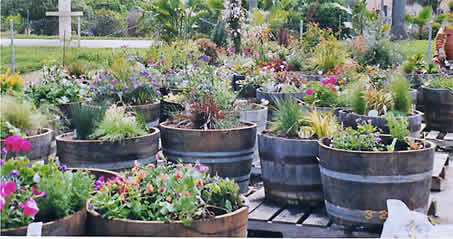Half barrels, redwood or cedar tubs or planter boxes, large clay or resin pots, and new galvanized horse water troughs are often used for school gardens. They are acceptable and decorative alternatives to a framed bed with an open bottom. Pots and small planters are especially useful for plants, such as mint, that would be invasive in the open garden. An advantage of small containers and some containers on wheels is that they can easily be moved indoors at night for cold protection. They can also be moved to take advantage of a sunny location.
Crops in containers need to be fertilized and watered more often than plants grown in beds with soil. They are also more sensitive to temperature extremes, and may need protection from the wind. Containers may need to be rotated to give the plants light from all directions.
If drainage holes are not already present in the half barrel, horse trough or other container, drill several 1 inch holes in the bottom of the container. Large drain holes can be covered, if desired, with a curved piece of broken pottery or weed-block fabric to prevent soil from being washed out.
Containers should be filled only with a commercial potting mix to provide good drainage and aeration. Garden soil should not be used in a container. It does not drain well, can harbor disease pathogens or weed seeds and it is very heavy. Putting a layer of gravel in the bottom of the container will not improve drainage of the soil above. Use a good quality potting mix and water it thoroughly several times to leach out harmful salts that may be present. Leave a 1 to 3 inch space at the top of the container to provide a basin to hold water and mulch.
